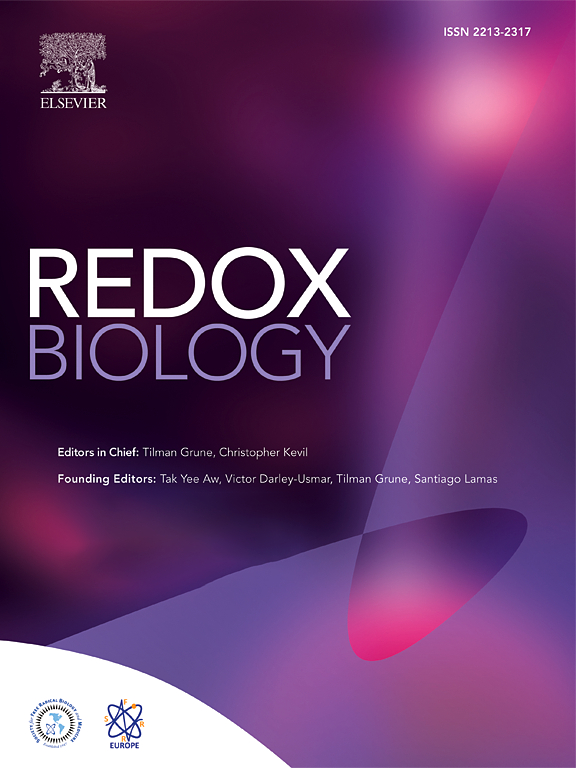铁催化的氧化应激通过线粒体靶向铁下垂损害BRCA2单倍体功能不全的癌症促进作用
IF 10.7
1区 生物学
Q1 BIOCHEMISTRY & MOLECULAR BIOLOGY
引用次数: 0
摘要
BRCA2的致病变异是各种癌症的遗传风险,包括乳腺癌、卵巢癌、胰腺癌和前列腺癌。同源重组不足导致的基因组不稳定被认为是致癌的原因。据报道,内源性或外源性醛,包括甲醛和乙醛,抑制BRCA2的功能。然而,BRCA2不足如何导致致癌的分子序列仍未阐明。为了评估基于Fenton反应的氧化应激是否是BRCA2单倍不全中致癌的促进危险因素,我们在这里将铁诱导的肾癌作用应用于新建立的大鼠BRCA2杂合突变模型(突变体T1942Kfs/+;无足轻重的人)。大鼠MUT模型,尽管自发性恶性肿瘤显著增加,但与我们之前使用Brca1突变大鼠的研究相比,对三醋酸铁(Fe-NTA)诱导的肾癌没有促进作用。在MUT肾细胞癌中,基于阵列的比较基因组杂交显示Cdkn2A纯合子缺失频率显著增加。然而,在给MUT单周或1周的Fe- nta治疗后的急性期肾脏分析显示,脂质过氧化受到抑制,与铁中毒抵抗一致,铁中毒和小管细胞再生共存,在给铁- nta治疗3周后,MUT亚急性期的细胞质催化铁(II)水平较高。机制上,线粒体功能障碍与过量的铁,促进不足的BRCA2可能是为了维持DNA的完整性,最终启动铁的过程。总之,铁依赖性氧化应激在致癌过程中对细胞死亡或增殖起着双刃剑作用,其生物学后果在BRCA2和BRCA1单倍不全中是不同的。我们的研究结果表明,铁催化的氧化应激不是BRCA2致病变异致癌的主要驱动力。本文章由计算机程序翻译,如有差异,请以英文原文为准。

Iron-catalyzed oxidative stress compromises cancer promotional effect of BRCA2 haploinsufficiency through mitochondria-targeted ferroptosis
Pathogenic variants in BRCA2 are hereditary risks for various cancers, including breast, ovary, pancreas and prostate. Genomic instability due to insufficient homologous recombination is thought as responsible for carcinogenesis. Reportedly, endogenous or exogenous aldehydes, including formaldehyde and acetaldehyde, suppress BRCA2 function. However, molecular sequences how BRCA2 insufficiency leads to carcinogenesis remains unelucidated. To assess whether Fenton reaction-based oxidative stress is a promotional risk factor of carcinogenesis in BRCA2 haploinsufficiency, we here applied iron-induced renal carcinogenesis to a newly established rat heterozygous mutation model of Brca2 (mutant, T1942Kfs/+; MUT). Rat MUT model, despite significant increase in spontaneous malignant tumors, showed no promotional effect on renal carcinogenesis induced by ferric nitrilotriacetate (Fe-NTA) in contrast to our previous study using Brca1 mutant rats. Array-based comparative genome hybridization of renal cell carcinoma in MUT revealed significant increase in the frequency of homozygous Cdkn2A deletion. Whereas acute-phase analysis of the kidney after single or 1-week Fe-NTA administration to MUT showed suppressed lipid peroxidation, consistent with ferroptosis-resistance, ferroptosis and regeneration of tubular cells were coexistent with higher cytoplasmic catalytic Fe(II) levels in the subacute phase of MUT after 3-week Fe-NTA administration. Mechanistically, mitochondrial dysfunction with excess iron, promoted by insufficient BRCA2 presumably for maintaining DNA integrity, eventually initiated ferroptotic process. In conclusion, iron-dependent oxidative stress plays double-edged roles either for cell death or proliferation in carcinogenesis and its biological consequences are distinct between BRCA2 and BRCA1 haploinsufficiency. Our results suggest that iron-catalyzed oxidative stress is not a major driving force of carcinogenesis in BRCA2 pathogenic variants.
求助全文
通过发布文献求助,成功后即可免费获取论文全文。
去求助
来源期刊

Redox Biology
BIOCHEMISTRY & MOLECULAR BIOLOGY-
CiteScore
19.90
自引率
3.50%
发文量
318
审稿时长
25 days
期刊介绍:
Redox Biology is the official journal of the Society for Redox Biology and Medicine and the Society for Free Radical Research-Europe. It is also affiliated with the International Society for Free Radical Research (SFRRI). This journal serves as a platform for publishing pioneering research, innovative methods, and comprehensive review articles in the field of redox biology, encompassing both health and disease.
Redox Biology welcomes various forms of contributions, including research articles (short or full communications), methods, mini-reviews, and commentaries. Through its diverse range of published content, Redox Biology aims to foster advancements and insights in the understanding of redox biology and its implications.
 求助内容:
求助内容: 应助结果提醒方式:
应助结果提醒方式:


